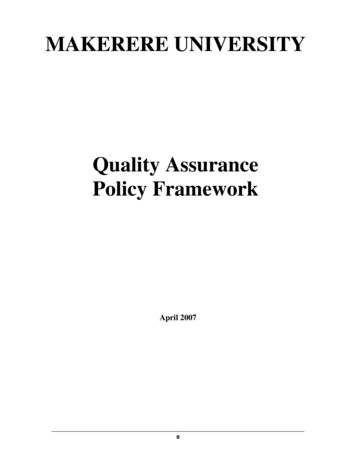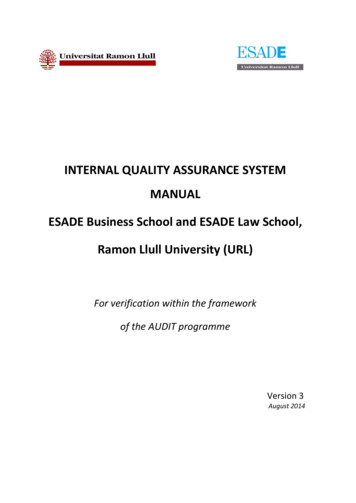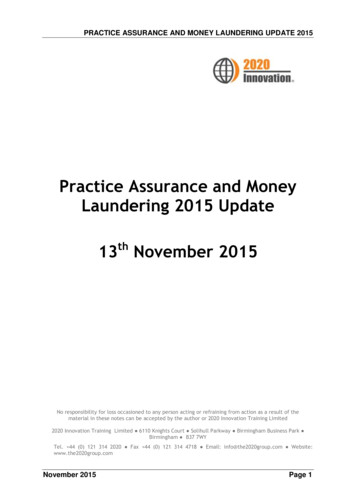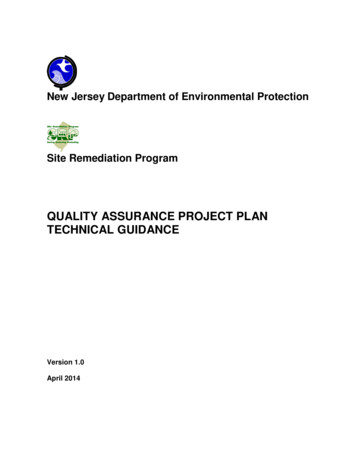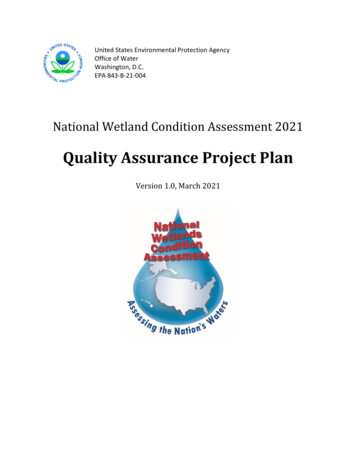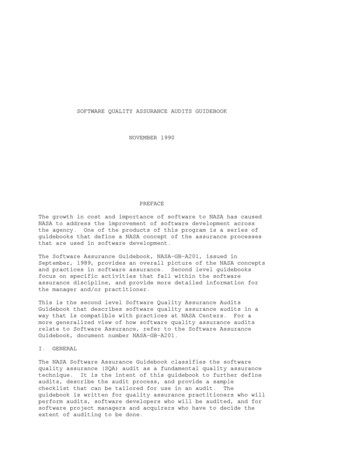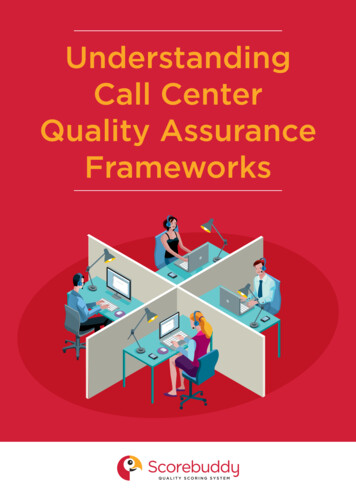
Transcription
UnderstandingCall CenterQuality AssuranceFrameworks
ContentsIntroduction3The Evolution of Call Center QA Frameworks5Operational Call Center QA Framework Defined11Tactical Call Center QA Framework Defined16Strategic Call Center QA Framework Defined20Key Takeaways23
IntroductionWhen it comes to call center quality assurance, the central issue for most organizationsisn’t why it needs to be a focus. It’s well known that the phone is considered the mostfrustrating customer service channel by US internet users, and it’s equally well known that40% of consumers have abandoned a company for one of their competitors due to subparcustomer service. Knowing, why organizations need to focus on quality assurance for theircontact centers isn’t a point that inspires much doubt or debate.Instead, what organizations should be focusing on is how to get better at assuring qualitycustomer service. Investing in an automated call center quality assurance solution is a goodstart, but like any business solution, it needs to be used carefully in order to produce thebest results.This means having a plan for everything from the starting point to the metrics beingtracked, the calls being monitored, and the way your agents are involved in the process.By doing so, they’ll be able to reap the biggest benefits for customer experience, customerloyalty, and ultimately, the bottom line.
IntroductionIt is not a secret: contact center qualityassurance measurement matters.Eighty-five percent of Quality AssuranceLeaders agree that evaluating agentperformance and training requirementsis fairly to highly impactful to contactcenter success. The challenge is notin knowing the importance of qualityassurance, but in the process andaccuracy of data collection and analysisfrom multiple sources.The process of evolving from one stageof QA effectiveness to the next is whatthis eBook explores. It provides actionableinsights and a new lens with which tounderstand call center quality assurance.Call centers and quality assuranceoperations, metrics and data-collection areever-evolving, and so it is helpful to think ofthem as overlapping stages or frameworks.A convenient way to think about thesestages of evolution is: Operational, Tactical,and finally, Strategic call center frameworks.In this paper we define and illustrate eachstage with specific case study examplesto make them readily accessible andunderstandable.In a business based upon human-tohuman interaction, there is no reason datafrom disparate sources should overwhelmdecision makers. When viewed froman overall quality assurance frameworkperspective, the data may be viewed ina dashboard with analytics that providedata-driven ways to help improve and toempower managers, call center employees,and clients.
Evolving a Strategic Call CenterQA FrameworkThere are overwhelming amounts of data points associated with call center qualitymonitoring and measurement. And there is no dearth of methods available by which tocollect those metrics. Time and resources are scarce and, for many, quality assurancedata collection technology is lagging.Challenges to managing performanceQuality Assurance Managers are typically tasked with analyzing large amounts of QAmetadata from both clients and callers who, to make things more complicated, oftenhave significantly different goals. These metrics are plentiful and complex and taketime to interpret and use to make actionable improvements and identify coachingopportunities. It is easy to get bogged down by seemingly endless data points fromclients and callers. One QA dashboard is required to simultaneously view all essentialdata points at-a-glance.
Taking a Step Back - A Look atthe Quality Assurance Big PictureThere are different types of call centerswhich vary by industry and by stages ofgrowth. However, when examined from atop-level perspective a natural evolutionis revealed. Each call center, at one timeor another, fits into, transitions through,or overlaps across three QA frameworks:operational, tactical, and strategicUnderstanding quality assurance throughthe lens of these evolutionary frameworksprovides a basis from which to identifygoals and pinpoint key performanceOperationalindicators, and more specifically, whichof those KPIs delivers the most strategiclong-term value.With an overarching ‘strategic framework’as the end goal in mind, it remains essentialto embrace elements of operational andtactical frameworks which all contribute toa larger picture of success. Knowing whichstage or stages your business is workingthrough will help inform decision-makingfor revenue growth.TacticalStrategic
Level2 3Operational Quality AssuranceAn essential starting point, an operationalcall center framework pertains to thoseaspects of quality assurance focusedon improving operational goals and onprocess and workflows. These representthe integral nuts and bolts activities thatget the job done on a day-to-day basis.Operational quality assurance helps toimprove workflow practices by: Maintaining consistent service delivery Identifying poor performers Measuring adherence to process andprocedure Tracking agent development andprogressOperational quality assurance covers all ofthe basics and is absolutely necessary ascompanies begin to lay the groundworkfor success in call center customer serviceand customer experience. While thereis nothing inherently wrong with thisapproach to improving customer service,it is important to note that significantwork may need to be done to evolvetowards a more strategic quality assuranceframework. However, a company, like itscall center, must be fully-operational beforemoving on to more tactical and strategicapproaches.Tactical Quality AssuranceA tactical quality assurance frameworkgenerally addresses a company’s mediumterm goals, with more flexibility andforesight than operational goals. Tacticalframeworks take a deeper dive intounderstanding the customer serviceexperience. Tactical QA frameworks tend tobe more changeable by definition.Tactical quality assurance goals include: Improving client retention Reducing staff churn/attrition Identifying knowledge gaps Looking for the root causes of poorservice Reporting on trends Aligning tightly with business goalsIn this context, call center agents areencouraged to self-score their own successmetrics on each of their calls, essentiallyacting as data collectors for QualityAssurance Leaders, who can now focuson coaching rather than merely on datacollection.
Voxpro is a well-established, award winning call center with a global influence and highprofile clients including Google, Stripe, and Airbnb. Voxpro was looking for a solution totheir data fatigue. They were challenged by a lack of time and resources to analyze andcorrectly interpret large volumes of QA meta-data. In this video Kieran from Voxproexplains how call center self-assessments drove customer satisfaction (CSAT) and NPS.A tactical framework eliminates additionallayers of data by personalizing the metricsand applying it specifically to the personbehind the phone.Empowering call center employees to takeownership of their own performance tendsto boost morale and reduce staff churn,but most importantly it outlines the rootcauses of poor service.Once identified, these root causes maybe directly addressed and improved.For example, employee self-scoringdata contrasted with caller feedbackoften reveals challenges in expectations.These expectation gaps are immediatelyidentified so that action may be taken toresolve direct pain points.Flexibility is built into this tacticalframework so that it can be built upon andmove towards a more strategic, big pictureapproach. But this stage of self-awarenessand root cause identity is neverthelessan essential stepping stone in crafting animproved customer experience.
Strategic Quality AssuranceA strategic QA framework approach takesinto account all critical influences from thecustomer, from the business, as well asfrom a compliance perspective. A companythat evolves towards a strategic qualityassurance framework is prepared to departfrom previous quality assurance practicesand procedures in order to potentiallyincrease revenue and ROI.Strategic QA frameworks are focused onlong-term impact and may suffer somesignificant growing pains before measuredimprovements take place. With a top-downapproach, senior leadership is charged withinfluencing employee buy-in towards thiscultural shift. While it may seem daunting,the potential wins far outweigh thestagnation of the status-quo.A strategic QA framework aims to: Improve Net Promoter Score (NPS) Increase customer loyalty Use QA as differentiator Improve propensity to purchaseImplementing a strategic framework movesthe business away from quality assurancescores and focuses instead on actionablebehaviors. When a call center has masteredboth Operational and Tactical levels, theyare ready to step away from the basicsand focus on what will deliver measureablebusiness results. It is a shift from a cultureof micromanagement to one of listening,evolving, and mutual respect. In simplestterms: happier call center representativesequal happier callers.
Defining a Great Customer Service ExperienceClients and call center representativesalike have the same goal: To use qualityassurance to achieve strategic goalsand drive positive customer serviceexperience.When call center representatives areasked to describe a great customerexperience in three words, thepredominant choices include: consistent,needs and expectations.Consider your own call center model andthink about where it may fit within theseoverlapping frameworks. Knowing whereyou on that are is essential in determiningwhere you are heading and how youwish to successfully get you and yourteam from ‘always the same’ to ‘alwaysevolving.’Defining the Operational Call Center QA FrameworkAn essential starting point upon which tobuild exists within the core of every callcenter. Process and workflows are theoperational framework of the call center.So, when we reference the operationalaspects of a given call center, we arespeaking to the day-to-day, nuts andbolts of getting the job done in the mostimmediate-term. These are the decisionsand actions that inform getting from pointA to point B in the most efficient andcustomer-centric way possible.Call centers that are working within theoperational QA framework typicallyemploy the following processes: Measure QA as part of the daily operation Develop a QA framework with a primary function of identifying poor performers Complete a quota of scores by staffper month Perform evaluations by team leadersthat are reviewed monthly
Operational QualityAssurance GoalsThere are four pillars of operational quality assurance that work to measure and ultimatelyimprove call center process and workflow practices. Of course there are challenges withineach, but understanding these issues is exactly what helps to evolve the framework andto build more tactical and strategic QA frameworks down the line.1 Maintain consistent service deliveryConsistency is key in most industries and functions, but especially important whenmanaging the personalized level of service call centers demand their employees deliveron a regular basis. And yet, CSAT (customer satisfaction) tops the list as an area wheremost call centers feel they need the most improvement. In fact, the focus on CSATimprovement is a staggering; 32% higher than sales and conversion rates.High customer feedback scores are what matter most to call centers and they are alsoone of the most difficult areas in which to achieve consistency.
Consistency can easily become one of the more subjective data points to measure,particularly within an operational framework where importance is placed on fulfilling aquota of monthly scores and on identifying poor performers. We must first define whatis meant by “consistent service delivery” and then benchmark attainable consistent datapoints that are not only measurable, but easily translatable to Quality Assurance Leaders,and shareable with their teams.2 Identify poor performersIdentifying poor performers seems like a noble effort, but in truth, within an operationalframework little time is available to effectively manage performance and quality. Whilethese metrics and their follow-through actions remain an important goal, most call centermanagers agree that “there is not enough time to analyze data” nor is there “time orresources available to coach and train.”Call center quality assurance data exists, but it is not easily translatable or streamlinedin a way that results in resource-driven measurements for appropriate identification orcoaching. Twenty-five percent (25%) of Quality Assurance Leaders agree that when itcomes to performance management, call center technology is a problem.
Once a poor performer is identified, the remaining challenge is to understand the ‘rootcause’ of why they are poorly performing and how to coach for greater success.3Measure adherence to process and procedureMeasuring the overall impact of a call center’s process and procedures is meaningful atall stages of the call center’s development, but particularly as it shifts to higher growthphases. Unfortunately, 55% of call centers polled admit that they do not know if theirquality assurance scores align with their customer feedback and CSAT scores.Meanwhile 48% do not know if any collected customer insights are shared elsewherewithin their respective organization. This means that the call center, where employees areclosest to understanding what customers think and feel, is not sharing any of these keylearnings with other departmental organizations.While process and procedure adherence may be measurable, it is not especially usefulif little or no action is taken based on the learned results. This makes the metrics lessmeaningful, potentially resulting in a cycle of poor or inconsistent data collection.
4 Track agent development and progressMonthly quota-based tracking checksthe box when it comes to tracking agentdevelopment and progress, but it is nota clear and effective way to coach ormotivate employees. These data points areoften convoluted and there is rarely timeto analyze results with any in-depth to lookinto what may really be going on.With most call centers unable to identifypoor call center performers it may comeas no surprise that tracking agent progressalso presents a challenge. Time is scarce foranalysis and dedicated coaching is oftenunder-resourced. Quality Assurance TeamLeaders are often performing evaluationsthat are reviewed on a monthly basis. Withmuch of this time spent on poor performeridentification, it remains a challenge tofocus on rewarding agent progress oranalyzing how agent development affectsthe greater good.Looking Forward to Tactical and Strategic FrameworksWhile quality assurance measurementexists through operational frameworks,there are seemingly countless missedgrowth opportunities. An operationallyfocused call center needs to be concernedwith daily tasks, workflows, and processes.But as innovations in live web chat andsocial media customer care continue totrend upward, call centers working withina strictly operational framework will not beable to keep up.It is best practice to consider call centerquality assurance as an evolution fromoperational to tactical to strategic. Theprocesses and workflows in an operationalframework are absolutely essential to callcenter success. This day-to-day, short termdecision-making is what begins to supportthe grander scheme tactical and strategicapproaches we discuss next.Defining the Tactical Call Center QA FrameworkIn sports, tactics are plans made beforethe start of a game, to play against youropponent’s weaknesses and to your team’sstrengths.We prefer the more managerial definition;Tactics are the actual means used to gain abusiness objective.
What it means to have a Tactical QA Framework ApproachAs business and by extension, thesupporting call centers mature, theynaturally evolve from operational to tacticalto strategic frameworks. To clarify, wemust recognize that all centers — thereare upwards of 45,000 in the US alone —as they mature will need to align (at leastsome aspects of their business) with atactical QA framework approach.Specifically, a call center taking a tacticalQA framework approach is typicallyfocused on the following more changeableaspects of measuring call center success: QA goals more often than not reflectmedium-term business goals QA is used as a method for identifyingprocess or service improvements whichare then adopted and implemented QA processes, workflows, and wins areused to sell business QA evaluations are pushed to agents inreal-timeA business should respond to me 24 hoursa day, 7 days a week4.8%3.6%22.9%Strongly agree8.4%15 - 24 years old25 - 30 years oldAgree28.9%Undecided20.5%31 - 40 years old36.1%41 - 50 years oldDisagreeStrongly disagree51 - 60 years old61 years old3.6%27.7%26.5%16.9%10 PREDICTIONS FOR 2017In the midst of so much call centertechnological innovation with stridesin artificial intelligence, live chat, socialmedia customer service efforts, andmobile-readiness, call centers must befast to adapt. Customer expectations areexceedingly high and getting higher.In this 10 Predictions for 2017 study byBrainfood, consultant Martin-Hill Wilsonpoints out that a growing portion ofcustomers agree or strongly agree that abusiness should respond or be available 24hours a day, seven days a week.It may be useful to keep this in mind as wereview call center QA tactical frameworksand look towards a larger goal-orientedpicture.
A Tactical ThoughtProcessMoving from operational to tactical means the internal conversation has to change. Thediagram below illustrates the typical thought process that you need to go through whenredesigning your QA framework.Tactical Goals and Actions Improve NPS by 3 point Reduce DSAT by 10% Identify Root Causes of DSAT Identify and fix broken processes1Redesign Scorecard criteria2Revise weighings and metrics3Share outcomes and results4Collaborate on solutionsWhat isimportant tothe BusinessWhat isimportant tothe Customer
Understanding Call CenterQA Tactical GoalsMore in-depth than operational call center QA goals, Tactical goals, for example, arefocused much more on growth and scalability than on processes and workflows.1 Improve client retentionNot only does a tactical framework demand consistent service delivery, but a level ofquality service that results in higher client retention.2 Reduce staff churnReducing staff churn saves on invested time and dollars in staff training and development,and ultimately assists in maintaining a healthy client retention rate. A tactical frameworkpoints to call agent self-scoring as a method of getting to the root cause of an issue (see#4) while empowering employees with self-awareness and a weighted say in why andhow a call succeeds or fails.As expressed in a case study with Voxpro, staff agents tend to be more motivated whendata measures success against more specific KPIs and can more fluidly inform directionshifts towards meaningful goals.3 Identify knowledge gapsWith an ability to look and see beyond the day-to-day process, a tactical frameworklens enables Quality Assurance Leaders and others to do the job of using metrics topinpoint specific knowledge gaps. These gaps may be found in the call center employeeknowledge base, or reach as far as enterprise-wide product and service issues. Tacticalframeworks begin to open this communication channel so that call centers can functionas a more holistic part of the client’s business by identifying knowledge gaps and raisingtrending call concerns through the ranks.
4 Look for the rootcauses of poor serviceRather than merely identifying poorperformers based on somewhatsubjective data points, a tactical callcenter QA approach digs deeper intoidentifying and understanding the trueroot cause of poor service. With a focuson the quality of the service rather thanon the individual performer, the idea isto strengthen and empower employeesthrough coaching and progress,ultimately reducing staff churn andimproving the customer experience.5 Report on trendsWith a focus on month-over-month,or year-over-year data, tacticalpivots can and should be made. Bycollating trending data as opposedto one-off data points or subjectivedata collection, Quality AssuranceManagers can make more informeddecisions.
Call Center QA Tactical Frameworksat Work: A Voxpro Case StudyA firm that has shifted to a QA Tacticalframework is illustrated in our customerexample and Voxpro case study.Voxpro is a well-established, award winningcall center with a global influence and highprofile clients including Google, Stripe, andAirbnb. Voxpro was looking for a solutionto their data fatigue. They were challengedby a lack of time and resources to analyzeand correctly interpret large volumes of QAmeta-data.The end goal at Voxpro was to evolve froman operational (process and workfloworiented) framework to a framework thatis tactical (changeable and flexible). TheVoxpro plan involved working to: Obtain a unified QA dashboard view ofall pertinent analyticsKieren McCarthy, Headof Quality at Voxpro,summarizes his team’stactical QA frameworksuccess and how he plansto build upon this into astrategic framework. Gain the ability to analyze the data inreal-time Implement new concepts of self-scoringand self-awareness for call centeragents.With these tactical goals at the fore,Voxpro identified exactly how astreamlined data solution could help themgrow and improve. This is a solid outlinefor any call center also suffering from anabundance of metadata and interested inevolving toward a tactical or even strategicway of doing business.The Voxpro success story continueswith increased growth, higher customersatisfaction (CSAT) scores, reducedemployee churn, as well as root causeidentification.
Next Steps: From a Tacticalto a Strategic QA FrameworkIn the Voxpro case study example, we learnhow flexible, medium-term business goalslead to greater client retention and higherCSAT scores while improving employeeturnover. Pockets of value are uncoveredby identifying knowledge gaps andtaking action to improve communications.Even QA processes begin to be lesscumbersome as metrics shift to a callcenter agent self-scoring process.Evolving from a catch-as-catch-canapproach within an operational frameworkof process and workflows, heading to amore tactically-influenced mindset, openssignificant opportunities for continuedgrowth through the strategic framework weexplore in our next chapter.Defining the Strategic Call Center QA FrameworkThe end goal for ultimate call centerQA efficiency is to be working within astrategic QA framework. This approachtakes into account all critical influences —the business, the customer, the client, andthe agent — and aims to seamlessly set thestandards, measure and collaborate acrossthese partnerships.Call centers that adhere to strategic QAframeworks are designed to deliver on thebusinesses’ strategic objectives and goals.They are structured to analyze, interpret,and share data that may result in actionsthat drastically depart from previousoperational practices. Because this highestlevel QA format is focused on long-termimpact, it must necessarily be facilitated bya top-down approach.Senior leadership is charged withinfluencing employee buy-in towards thepotential cultural shifts that may comeabout due to key data findings. Theyare rewarded as top-notch; QA (and thedata associated therein) becomes a keydifferentiator and selling point responsiblefor significant revenue growth anddelivering real shareholder value.
Working within the strategic QA framework focuses on the following processes: Correlating and understanding the connection between Customer Experience,Customer Sentiment, and QA. Considering and reviewing QA from positions of senior leadership, or on the executiveboard level. Evaluating consistent QA as a senior management key performance indicator (KPI). Encouraging call center agents to score themselves as a way to raise levels of selfawareness, and adopt customer positive behaviors.Who Defines Quality?12e.g. Customers, Regulators,Leadership, Advisors, OthersWhat is Success?8e.g. Metrics, Behaviours,FeedbackHow is Quality Improved?7e.g. Performance Mgt,Coaching, 'Fixing It',Best PracticeWhy Get Invoved?e.g. Recognition, Reward,Career, BeliefFor Which Outcomes?3StrategicQualityFramework65e.g. Performance, Compliance,Improvement, InnovationFrom What Inputs?4e.g. External Surveys,Internal Surveys, Evaluations,AnalyticsWhat Drives Quality?e.g. Process Based,Systems Based, NeedsBased, Self ManagedWho Gets Invoved?e.g. Leadership, Team Leaders,Quality Team, Peer to Peer,AnalyticsA visual representation of strategic thinking at work. Discover how higher level strategicpartnerships emerge and how quality is driven with this Strategic Quality Frameworkchart by Martin-Hill Wilson, the founder of customer service and customer experienceconsultancy, Brainfood.
Strategic Quality Assurance GoalsWhile it may seem as though strategic-oriented frameworks enable call center employeesand team leaders the luxury of stepping back to philosophically address the biggerpicture, this is not the case. Yes, more time is certainly dedicated to longer-term thinking,but big organizational changes are often necessary as a means to experience growth,consistently high net promoter scores, and increased returns-on-investment. The questionis whether the QA Framework is seen as capable of moving the needle on these headlineKPIs?1 Improve Net Promoter Score (NPS)Net Promoter Score goes a few steps beyond CSAT as it focuses on how a customermight promote, or recommend a given call center’s services. On a scale of zero to ten,only an NPS score of nine or ten qualify as a “promoter.” Promoters are the goal; they arethe ones most likely to spread the good word about a company or call center. The othersclassified as either “passives” or “detractors,” and as their names suggest, are not veryhelpful.2 Increase customer loyaltyCustomer loyalty metrics look beyond first-time callers and one-off interactions and focusinstead on repeat business rates. Knowing who these people are, where they are comingfrom, and why they continue to come back, proves to be invaluable client and call centerinformation.3 Use QA as a key differentiatorAs QA data collection and the streamlining of data interpretation improve, QA shifts froma poor performer identifier in an operational framework to a selling point to potentialclients in a strategic framework.4 Improve the propensity to purchaseThe end goal is to increase sales. While operational QA frameworks are concerned withproviding consistent service, a strategic approach is to examine how that service isimpacting a customer or potential customer’s propensity to purchase.
How to Become a More Strategic Call Center – ‘Always the Same’to ‘Always Evolving’First, identify under which framework your call center currently exists: operational, tactical,or strategic. Next, be certain your call center is prepared to evolve to the next framework.Strategic, for example, requires the cooperation of senior leadership, so make sure thekey players are aligned in their focus on growth. Remember also that call centers rarely,if ever, fall exclusively under one framework and that these are constantly shifting andoverlapping constructs.While working with a strategic framework is a call center’s ultimate goal, there is importantwork to be done within the stages of operational and tactical development. Identifywhere you are and take action.Key TakeawaysCustomer service remains a fast-growing aspect of most businesses and an industry thatcontinues to become more and more influential to business growth, customer retention,and brand loyalty. How we measure that service and take action to improve its results, iscritical to implementing data-driven improvements and driving revenue increases.While there are varying degrees of what defines data-driven success, we know that astrategic QA call center framework aims specifically at: Improving Net Promoter Score (NPS) Increasing customer loyalty Using QA as a differentiator Improving a client’s propensity to purchaseMeasurement goals ensure that data is grounded and meaningful. These goals will not beimmediately met, but when envisioned as an evolutionary process, the journey to gettingthere may be more impactful.
Braindfood’s Martin H. Wilson shares some valuable insights in moving towards a strategicframework. In his recent study, “Setting Your Customer Service Strategy,” Wilson suggestsshifting the following operationally-focused call center ideas to ones of greater impactand significance. He encourages call centers to move from regimented thinking to a morecreative approach From Scores to Agent Behaviors From Telling to Learning From Micro-Management to Mutual Respect From Assuming to Listening From ‘Always the Same’ to ‘Always Evolving’There are 41,500 call centers in the US alone where call center operations are forecastedto create 365,000 new jobs in the next four years. Competition continues to rise alongwith innovative strides in customer service surrounding AI, live chat, and voice interfaces.Evolving from ‘always the same’ to ‘always evolving’ is the future of call center QA. Whileit is expected that call center leaders may find themselves engaged in different pointsalong the quality assurance journey, to refuse to evolve in this fast-growing industry isfailure. To evolve through operational, tactical, and strategic frameworks can point youtoward greater success.Multichannel? Try Anychannel!Use Scorebuddy to Quality Assess Calls, Chat,Email, Social Media, white-mail. anything.www.scorebuddyqa.comVISIT THE WEBSITESCOREBUDDY COREANALYTICSAGENT INSIGHTSCORECARDS, CALIBRATION,COMPLIANCE, REPOR
understand call center quality assurance. Call centers and quality assurance operations, metrics and data-collection are ever-evolving, and so it is helpful to think of them as overlapping stages or frameworks. A convenient way to think about these stages of evolution is: Operational, Tactical, and finally, Strategic call center frameworks.
